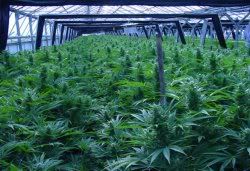
There's a budding movement urging cannabis growers to ask themselves: How green is your grass?
A recent energy-use report authored by one California scientist and a Humboldt County-based group are taking a sharp look at the carbon footprint of industrial-scale indoor cannabis growing. An ordinance in Boulder requires medical-cannabis dispensaries to pay carbon offset fees. All of them are concerned about the environmental impacts as the medical cannabis industry grows ever larger.
But first, a quick history lesson in indoor growing: A few decades ago, a bunch of hippies trekked off to the rural lands of Humboldt County, Calif., to create idyllic, off-the-grid communities. When their kids got old enough to drive, growing cannabis and selling marijuana became the way to pay for gas. But as the CAMP raids started up in the 1980s, growers had to move their operations indoors. Elaborate lighting systems were created to maximize growth cycles. Fuel had to be trucked over miles of dirt roads to run the generators that kept the operations going.
Today, as sixteen U.S. states have approved medical cannabis, it's becoming easier for entrepreneurs to set up elaborate energy-sucking cannabis nurseries. And all that indoor cannabis comes with high energy costs.
In April, energy and environmental systems analyst Evan Mills released his report "Energy Up in Smoke," which examined the energy usage and carbon footprint of indoor cannabis growing operations. (While Mills is a staff scientist at the Lawrence Berkeley National Laboratory, his website emphasizes that the report was conducted independently and on his own time.)
Consulting with an indoor growing expert, Mills crunched the numbers for running all those high-intensity lights, pumps, dehumidifiers, heating and irrigation systems, plus the electric gadgets that control them.
The report finds that nationwide, "indoor Cannabis production results in energy expenditures of $5 billion each year, with electricity use equivalent to that of 2 million average U.S. Homes." All related CO2 production, including transportation, equals that of 3 million cars.
In California, where the growing medical cannabis industry still has a sort of Wild West feel, indoor growing is responsible for about 3 percent of the entire state's electricity use, or a staggering 8 percent of household use.
Mills finds that producing just one joint creates two pounds of CO2 emissions. One indoor off-grid plant -- like that in rural areas that use power from diesel generators -- requires 70 gallons of diesel fuel to grow.
Mills writes that cost-effective efficiency improvements of 75% are conceivable, and that "shifting cultivation outdoors eliminates most energy uses (aside from transport)."
In other words: to grow the greenest weed, outdoor is the way to go.
But as Sacramento-area dispensary owner Kris Burnett points out, there are hurdles keeping many growers from moving outside, especially in urban areas, such as crop security, exposure to law enforcement, and ever-changing local pot regulation ordinances.
"Nobody knows what [Sacramento] County is planning to do," says Burnett, who opened her collective in June. "It's a grey area with the law."
She also points to patients who live in assisted living homes or apartments with no place to grow outdoors.
Charley Custer, a member of the green-growing advocacy group Grow it in the Sun, says that his organization doesn't speak out against patients who cultivate their own medication in their closets at home."What we're trying to do is raise awareness of the destructive and even insane practices of industrial and commercial growers," says Custer. "We have nothing to say against whatever practices individuals use to get their own medicine."




No comments:
Post a Comment